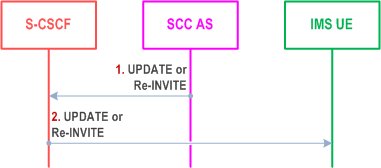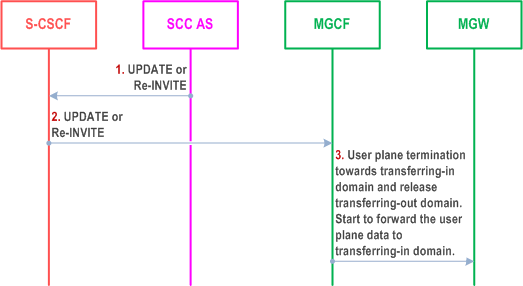Content for TS 23.237 Word version: 18.0.0
0…
4…
5…
5.4…
6…
6.2…
6.2.2…
6.3…
6.3.2…
6.3.2.1.3…
6.3.2.1.7…
6.3.2.1.9…
6.3.2.2…
6.3.2.3…
6.3.2.3.6…
6.3.3…
6.4…
6a…
6a.3…
6a.4…
6a.4.3…
6a.4.5…
6a.4.7…
6a.4a…
6a.5…
6a.6…
6a.7…
6a.8…
6a.9…
6a.10…
6a.11…
6c…
7…
A…
B…
C…
6.3 Access Transfer
6.3.1 Access Transfer Procedure
6.3.1.1 Introduction
6.3.1.2 Access Transfer Procedures
6.3.1.2a Access Transfer Procedures using ATCF enhancements
6.3.1.3 Enablement of Access Transfer procedures
6.3.1.3a Enablement of Access Transfer procedures using ATCF enhancements
6.3.1.4 Execution of Access Transfer procedures
6.3.1.4a Execution of Access Transfer procedures using ATCF enhancements
6.3.1.5 Remote Leg Update
6.3.1.6 Source Access Leg Release
6.3.1.7 Access Transfer Information for ATCF
...
...
6.3 Access Transfer p. 45
6.3.1 Access Transfer Procedure p. 45
6.3.1.1 Introduction p. 45
Access Transfer procedures enable service continuity between Access Networks. All Access Transfer procedures associated with a session, including initial and subsequent transfers, are executed and controlled in the user's home IMS network by the SCC AS upon the UE's request, except when using (v)SRVCC enhanced with ATCF or when using 5G-SRVCC. When (v)SRVCC enhanced with ATCF is used or when 5G-SRVCC is used, Access Transfer procedures are executed and controlled in the serving network. SCC AS and ATCF may handle the access transfer procedure with priority if the transfer request is initiated with priority indication.
The STN and STI are used during the execution of Access Transfers. The STN and STI are stored in the UE. The STN for DRVCC can be provided dynamically to the UE during session setup to provide the current updated address to the SCC AS.
6.3.1.2 Access Transfer Procedures p. 45
When the UE determines that Access Transfer is desirable and possible, a registration in IMS is performed by the UE via the transferring-in Access Network if the user is not already registered via that network.
If the UE does not have or is unable to use its ICS capabilities, then prior to dual-radio Access Transfer:
- If the MSC Server assisted mid-call feature is not used then the UE releases all but the most recently active bi-directional sessions.
-
If the MSC Server assisted mid-call feature is used then:
- if the UE has more than one active bi-directional session, selects the second most recently active bidirectional session and it releases all remaining sessions except for the two most recently active bi-directional sessions;
- if the UE has one active bi-directional session and more than one inactive bi-directional session, it releases all sessions except for the active session and the inactive session which became inactive most recently.
6.3.1.2a Access Transfer Procedures using ATCF enhancements |R10| p. 46
A new Access Leg is established by the MSC Server toward the ATCF and then to SCC AS when performing a PS to CS access transfer. When performing a CS to PS access transfer, a new Access Leg is established by the UE toward the ATCF and then to SCC AS. The ATCF subdivides the new Access Leg into a Serving Leg and a Home Leg. Signalling and bearer resources are allocated in the transferring-in Access Network and the user's sessions are transferred from the transferring-out Access Network. The ATCF executes Access Transfer procedures in co-operation with the SCC AS. Resources in the transferring-out Access Network are subsequently released by the SCC AS.
6.3.1.3 Enablement of Access Transfer procedures p. 46
A 3pcc (3rd party call control) function is employed to anchor IMS sessions at the SCC AS upon session establishment for enablement of Access Transfer. The SCC AS is invoked as part of originating or terminating iFC execution at the subscriber's S-CSCF. The SCC AS inserts itself in the signalling path of the SC subscriber's IMS sessions by implementing a 3pcc (3rd party call control) function. For an originating IMS session, the SCC AS terminates an Access Leg from the user and establishes a Remote Leg toward the remote end. For a terminating IMS session, the SCC AS terminates a Remote Leg from the remote end and establishes an Access Leg toward the user. The SCC AS subsequently coordinates the session control signalling exchange between the Access Leg and the Remote Leg associated with the anchored IMS session.
For 3pcc at the SCC AS when the Access Leg is established with CS media, refer to clause 5.4.3. For 3pcc at the SCC AS when the Access Leg is established with media flow over IP-CAN to illustrate its use as preparation for Access Transfer procedures, refer to clause 5.4.2.
An STI and STN for Access Transfer between CS and PS access shall be statically configured on the UE regardless of its ICS capabilities.
If the Gm or I1 reference point is used for the originating or terminating session, an STI is dynamically assigned for the Access Leg. An STI shall also be dynamically assigned for each new Access Leg established during Access Transfer.
The statically configured STI shall be used for Dual Radio CS to PS Access Transfers only when no dynamically assigned STI was provided to the UE.
The STN is used for PS to CS Access Transfers when no Gm or I1 reference point is available.
The STN-SR as specified in TS 23.216 is used for PS to CS Access Transfer using Single Radio VCC.
6.3.1.3a Enablement of Access Transfer procedures using ATCF enhancements |R10| p. 47
IMS sessions and media flows are anchored by the ATCF upon session establishment for enablement of Access Transfer using ATCF enhancements. For both originating and terminating IMS sessions, the ATCF subdivides the Access Leg into a Serving Leg and a Home Leg. During registration procedure, the ATCF allocates an STN-SR addressing itself and provides it to the SCC AS. The SCC AS provides the received STN-SR to the HSS and the HSS provides the STN-SR to the serving node(s), i.e. to SGSN and / or MME.
When CS to PS SRVCC is supported, a dynamic STI-rSR for Access Transfer shall be provided to the UE by the ATCF.
6.3.1.4 Execution of Access Transfer procedures p. 47
Upon detection of conditions requiring Access Transfer, the UE establishes a Target Access Leg with the SCC AS via the transferred-in Access Network to request Access Transfer to the transferred-in Access Network. When the UE initiates a Access Transfer request, it includes the STI and/or the STN.
The SCC AS executes the Access Transfer procedure by replacing the Source Access Leg currently communicating to the Remote Leg with the Target Access Leg. If no media flow is retained in the transferred-out access, the Source Access Leg is released as specified in clause 6.3.1.6. If the UE chooses to retain some media flow(s) in the transferred-out access, the Source Access Leg is updated to indicate which media flow(s) is retained in the transferred-out access. If such update is not done, the SCC AS releases the Source Access Leg as specified in clause 6.3.1.6 and updates the Remote Leg if necessary. When the switch of the Source Access Leg to the Target Access Leg is executed, the Remote Leg is also updated in order to forward the media flow(s) to the transferred-in Access Network.
6.3.1.4a Execution of Access Transfer procedures using ATCF enhancements |R10| p. 47
The ATCF executes the Access Transfer procedure by replacing the Source Access Leg currently communicating to the Remote Leg with the Target Access Leg. If no media flow is retained in the transferred-out access, the Source Access Leg is released as specified in clause 6.3.1.6 by the SCC AS. If the UE chooses to retain some media flow(s) in the transferred-out access, the Source Access Leg is updated to indicate which media flow(s) is retained in the transferred-out access. If such update is not done, the SCC AS releases the Source Access Leg as specified in clause 6.3.1.6 and updates the Remote Leg. When the switch of the Source Access Leg to the Target Access Leg is executed and the ATCF did not anchor the media in the ATGW, the Remote Leg is also updated in order to forward the media flow(s) to the transferred-in Access Network.
6.3.1.5 Remote Leg Update p. 47
Upon receiving a request for execution of Access Transfer, the SCC AS performs the Remote Leg Update by switching the Access Leg communicating with the Remote Leg from Source Access Leg to Target Access Leg.

The remote end in Figure 6.3.1.5-1 represents a UE supporting terminations per TS 23.228 (i.e. including NI-T).
Step 1-2.
The remote end in Figure 6.3.1.5-2 represents an MGCF for CS/PSTN Remote Party.
The SCC AS updates the Remote Leg by communicating the SDP of the Target Access Leg established to the remote end via the user's S-CSCF. Remote Leg Update happens according to SIP session modification procedures (see RFC 3261). The priority indication from the Target Access leg (i.e., from the access transfer request) does not change the existing priority setting toward the remote leg between the SCC AS and remote end.

Step 1-2.
These steps are the same procedures described in Figure 6.3.1.5-1.
Step 3.
MGCF instructs MGW to update a termination towards the Target Access Leg to the context, and to release the termination for the Source Access Leg from the context.
6.3.1.6 Source Access Leg Release p. 48
When the session modification procedures are complete, the Source Access Leg Release is executed by initiating a session release. This is done for the Source Access Leg using the AS/UE session release procedures per TS 23.228. For non-emergency sessions, the UE and the SCC AS shall initiate the Session Release procedure when the switch to the Target Access Leg is complete. For emergency sessions, the UE and the EATF shall initiate the Session Release procedure when the switch to the Target Access Leg is complete. For (v)SRVCC, the source access leg release is only performed if the UE retains Gm after the PS-CS access transfer is completed; otherwise, the UE release the source access leg locally.
6.3.1.7 Access Transfer Information for ATCF |R10| p. 48
When SRVCC with ATCF enhancements are used, a prerequisite for the access transfer to take place, is that the ATCF have received the Access Transfer Information from the SCC AS. The Access Transfer Information includes the ATU-STI and the C-MSISDN.
The SCC AS initiates the Access Transfer Information information exchange
- after the registration, if ATCF is included in the path, and the UE is SRVCC capable, and
- in the event the UE changes SRVCC capability provided that ATCF is included in the registration.

Step 1.
The UE performs an IMS registration that is sent through the ATCF according to the procedures of clause 6.1.2.
Step 2-3.
After the registration, at least prior any access transfer takes place, the SCC AS provides the Access Transfer Information towards the ATCF, by sending a message including the ATU-STI and C-MSISDN.